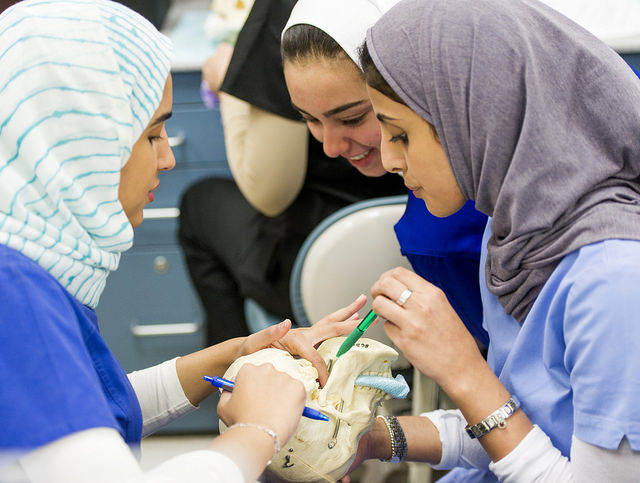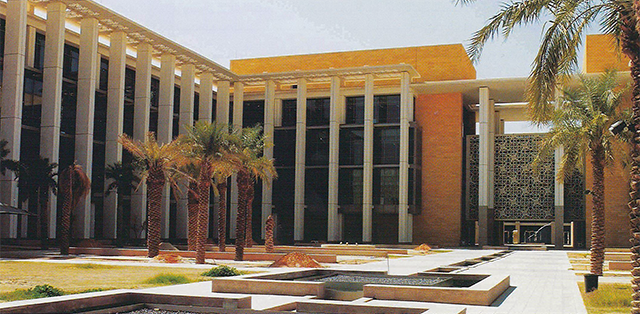Opening the door to international collaboration

Clinical experiences are a highlight for participants from Princess Noura bint Abdulrahman University dental school during a monthlong enrichment program in Dallas

Meet Hessa. There’s not a whole lot this young girl doesn’t do: She’s just as likely to cough or sneeze during appointments as she is to close her mouth in fatigue, hyperventilate, or simply complain of a hurting tooth. Her behaviors help second-year dental students feel more comfortable with practical skills and chairside manner before they begin seeing patients in clinic. There’s one more thing: Hessa is a robot.
Hessa, a dental simulator, can be found at the Princess Nourah bint Abdulrahman University (PNU) College of Dentistry in Riyadh, Saudi Arabia, which opened in 2012 and is one of 15 colleges within PNU, an all-female university with more than 50,000 students. At the PNU dental school, Hessa is right at home in bright clinics and labs replete with state-of-the-art technology, including Moog dental training simulation systems.

Since PNU is a new school, it is still building its patient pool, something that takes time. An established patient base and diverse array of cases is one of the factors that sparked PNU leaders’ interest in pursuing an international partnership with Texas A&M University Baylor College of Dentistry. This way, PNU dental students can be exposed to as many oral conditions and treatment modalities as possible while their own program is in its infancy.
It should come as no surprise that observation in TAMBCD clinics has been a highlight during the four-week International Dental Student Summer Enrichment Program, which started June 1 in Dallas.
“I remember the first day in the oral diagnosis clinic. I was amazed by the amount of different cases I saw, such as pleomorphic adenoma (salivary gland tumors), Stafne bone defect (asymptomatic lingual bone depression of the lower jaw), gunshot cases and bone graft surgery,” says Mehdiya Haider, a fourth-year dental student at PNU and one of 15 participants in the enrichment program. “Every day during rotations I learned something new; all the doctors had their own techniques, and they loved sharing them with us,” she adds. It’s a deviation from Haider’s typical patient base; she, like her classmates, treats mostly fellow PNU students.
Participants’ experiences are not limited to the clinic. They have received lecture and hands-on instruction ranging from ethics to onlay casting, crown and bridge preparation, and mouthguard fabrication. The program represents two years of planning between TAMBCD and PNU, with preparations already in the works for next year, says Dr. Loulou Moore, associate professor in restorative sciences and director of the summer enrichment program. There may be potential to develop a faculty exchange program with visiting professorships.
Dr. Hoda Abdellatif, Vice Dean of Students Affairs at PNU as well as an adjunct professor at TAMBCD, helped facilitate planning for the program starting in 2013, shortly after joining the PNU College of Dentistry.
“Such a program will expose the PNU students to learn from the differences in clinical care, dental education and culture at the TAMBCD institution, and it will also create a student network between PNU and TAMBCD dental students,” says Abdellatif. “This is hopefully the starting point for further collaboration between the two institutions.”

The exchange program also offers the chance for dental students to see how disease patterns vary in different areas of the world, says Dr. Ebtissam Al-Madi, dean of PNU College of Dentistry.
“It impacts dentistry first of all by breaking some barriers, especially with our faculty or students who might think that dentistry is performed differently in the U.S.,” Al-Madi says. “It shows them that dentistry is dentistry wherever you are in the world. It gives them a little addition in terms of seeing the patterns of disease in the States compared with Saudi Arabia,” she added, explaining that the program at TAMBCD may reveal more to PNU students about geriatric dentistry concerns, as the majority of their patient base consists of young, college-age adults. It mirrors the nation’s demographics a whole, as 48.6 percent of the population in Saudi Arabia is 25 years old or younger, according to the PNU dental school website. Al-Madi observes an interesting trend among this population in Saudi Arabia: high rates of dental decay among young adults from high and low socioeconomic groups because of lack of awareness of good oral hygiene coupled with a shift toward diets containing more sugar than in generations past.
Faculty and students agree that the importance of partnerships like the one between TAMBCD and PNU is highlighted as our world becomes increasingly connected.
“This program is an open channel for exchanging knowledge, and it’s good to collaborate,” says participant Tolean Jundieh, who is beginning her third year in PNU’s five-year curriculum. “We are one world now; and there is globalization in all levels, even in dentistry.”